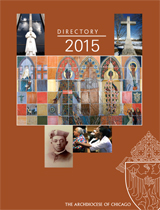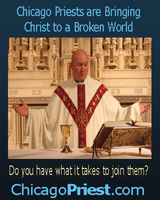April 27, 2008
Chicagoans see pope as a ‘real person’
When Pope Benedict XVI came down the stairs from the chartered Alitalia Boeing 777 — nicknamed “Shepherd One” by journalists and air-traffic controllers — that brought him and his entourage from Rome April 15, he was greeted by Catholic school students singing “Happy Birthday,” military personnel and their family members waving gold-and-white Vatican flags and warm greetings from President and first lady George W. and Laura Bush.
Dozens, if not hundreds, of Chicagoans added their voices to the warm welcome to Pope Benedict over his six-day visit to Washington, D.C. and New York.
Most prominent was Cardinal George, who, as president of the U.S. Conference of Catholic Bishops, was among the first to greet the pope on the tarmac at Andrews Air Force Base in Maryland.
But Chicago’s six auxiliary bishops all traveled to Washington for the pope’s meeting with the nation’s bishops April 16 in the crypt church of the National Shrine of the Basilica of the Immaculate Conception. They were invited to the formal welcoming ceremony on the South Lawn of the White House that morning — a ceremony that included more than 12,000 guests — and joined the pope in celebrating Mass at Nationals Park in Washington the morning of April 17.
All of the Washington, D.C. events took place under sunny blue skies, creating a spectacular backdrop.
‘Encouraging’ words
For Auxiliary Bishop George Rassas, the White House ceremony was a high point, with all the “pomp and circumstance” it included: the playing of the U.S. and Vatican national anthems, both flags flying, soprano Kathleen Battle singing the “Our Father” and remarks by President Bush and Pope Benedict.
“They really pulled out all the stops,” Bishop Rassas said.
As for the pope’s meeting with the bishops, the pope was “encouraging,” Rassas said.
In his remarks following the April 16 vespers service, Pope Benedict referred to the generosity of American Catholics, as well as the sense of faith prevalent in the United States.
“Let me express my particular appreciation for the many forms of humanitarian assistance provided by American Catholics through Catholic Charities and other agencies,” the pope said. “Their generosity has borne fruit in the care shown to the poor and needy, and in the energy that has gone into building the nationwide network of Catholic parishes, hospitals, schools and universities. All of this gives great cause for thanksgiving.
“America is also a land of great faith. Your people are remarkable for their religious fervor and they take pride in belonging to a worshipping community. They have confidence in God, and they do not hesitate to bring moral arguments rooted in biblical faith into their public discourse. Respect for freedom of religion is deeply ingrained in the American consciousness – a fact which has contributed to this country’s attraction for generations of immigrants , seeking a home where they can worship freely in accordance with their beliefs.”
But, Bishop Rassas noted, the pope also challenged the bishops in their role as shepherds of the faithful.
“While it is true that this country is marked by a genuinely religious spirit, the subtle influence of secularism can nevertheless color the way people allow their faith to influence their behavior,” Pope Benedict said. “Is it consistent to profess our beliefs in church on Sunday, and then during the week to promote business practices or medical procedures contrary to those beliefs? Is it consistent for practicing Catholics to ignore or exploit the poor and the marginalized, to promote sexual behavior contrary to Catholic moral teaching, or to adopt positions that contradict the right to life of every human being from conception to natural death? Any tendency to treat religion as a private matter must be resisted. Only when their faith permeates every aspect of their lives do Christians become truly open to the transforming power of the Gospel.”
But even the words of challenge were delivered with an encouraging tone, Rassas said.
Vincentian Father Dennis Holtschneider said he was encouraged by the Holy Father’s message to Catholic educators.
Holtschneider is president of DePaul University in Chicago, the largest Catholic university in the United States.
“When he begged the religious orders not to give up their schools, that was a powerful moment,” Holtschneider said. “A little encouragement goes a long way. It’s great to have the pope encourage us and thank us.”
Holtschneider also noted that Pope Benedict spoke three times of making sure that the poor have access to Catholic education. That’s near and dear to his heart, as DePaul has traditionally been a school for first-generation college students. While its prestige — and tuition rates — have risen in recent years, much of De- Paul’s financial aid is earmarked for those students who are the first in their families to attend college.
On the subject of Catholic identity, a topic of sometimes contentious discussion between Catholic universities and church hierarchy for at least 20 years, the Holy Father “had a very nice way of handling it,” Holtschneider said.
“He said we have to make sure the students can always find a place of faith on our campuses,” he said. “You can’t use academic freedom as an excuse to keep students from being able to find the ultimate truth.”
Holtschneider said he has planned a series of three meetings at DePaul, with the board of trustees, with the faculty, and with the general university community, to discuss what changes should be made in light of Pope Benedict’s words.
Reverence, enthusiasm
Father Michael Boland, president and administrator of Catholic Charities of the Archdiocese of Chicago, was in Washington, D.C. for board meetings of Catholic Charities USA, and was also invited to the White House welcoming ceremony and the Mass at Nationals Park — a Mass also attended by his brother, Father Jeremiah Boland, pastor of Holy Family Parish on Roosevelt Road.
“Seeing the president and the Holy Father together at the White House was cool,” Father Michael Boland said.
Boland appreciated the nod given to Catholic Charities in the talk with the bishops, he said, and was impressed by the reverence and enthusiasm he saw all around him at the Mass.
For Bishop Thomas Paprocki, the visit offered his third chance to personally greet Pope Benedict since he became pope. Bishop Paprocki saw the pope when he led a pilgrimage to Rome during Holy Week in 2007 and again in January, when the pope held an audience for participants in a symposium on the 25th anniversary of the Code of Canon Law.
On this visit, Pope Benedict appeared to be enjoying the attention he received, especially from young people.
“He seems very enthusiastic,” Bishop Paprocki said. “He’s in very positive spirits. When he arrived at the Mass the crowd seemed to energize him. People were cheering, and he was waving to them.”
Loved by youth
More Chicago young people saw the pope in New York than in Washington, D.C., as more tickets to the April 20 Mass at Yankee Stadium were made available in Chicago.
Patsy Laird, 16, of Arlington Heights, traveled with a group of nine young women and attended a youth rally in Yonkers April 19 as well as the Mass.
“It was just awesome,” said Laird, a junior at Willows Academy in Des Plaines. “He’s the leader of our faith. It’s a once in a lifetime opportunity.”
Rich Meyer, headmaster of Northridge College Prep, a boys’ school started by members of Opus Dei, jumped at the chance to take a group of students to New York for the Mass — even though he had to get names, birthdates, addresses, and a commitment to make (and pay for) the trip to organizers within 24 hours of finding out they could go.
He ended up with a group of about 65 students and 15 chaperones. Unable to find hotel accommodations, the group slept on the floor of the parish center at St. Paul the Apostle Church in Manhattan.
“We told them this was a pilgrimage, and there were things that would not be easy,” Meyer said, adding that he suggested that the young men offer their hardships up in solidarity with the pope’s intentions.
For many of the students, Meyer said, the real lesson of the pilgrimage was not that tens of thousands of people would travel to see the successor of St. Peter. Is was that Pope Benedict, the vicar of Christ, is a real person, not a virtual character who doesn’t inhabit the same world they do.
“When they saw him in person, they could see his humanity,” he said.
 Catholic
New World - Newspaper for the Archdiocese of Chicago
Catholic
New World - Newspaper for the Archdiocese of Chicago Archdiocese of Chicago Directory
Archdiocese of Chicago Directory Oficjalne wydawnictwo Archidiecezji Chicago w języku polskim
Oficjalne wydawnictwo Archidiecezji Chicago w języku polskim